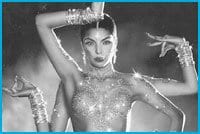Wandering into any retail store this spring, one finds shelf after shelf of fashions featuring Indian patterns, beading and sequins. Brownness is in – for a season at least.
Even mainstream not-for-profit organizations have gotten in on the cultural cash cow. Nowhere is it more apparent than this year’s Fashion Cares, the AIDS Committee Of Toronto’s annual high-end fundraiser. Styled Bollywood Cowboy: East Meets Western, the theme brings together the dazzling glamour of the massive Indian film industry and the imagined romantic nostalgia of the Wild West. Cowboys and “Indians.” Get it?
The images that have been used to promote Fashion Cares are compelling: stylish, sexy and playful. But I also find them disturbing. They feature beautiful models – all but one of whom are white or extremely fair-skinned – wearing cowboy hats, boots and other Wild West paraphernalia, but also hennaed and decked out in sequined Indian textiles, and posing the way we imagine brown people do, with the hands held just so.
One fair-skinned woman sits like the black goddess Kali, her multiple arms waving. The Western world has long parodied her, but the worship of Kali is quite real, and practised by millions of people. And do I even want to read into the arrogant stances of conquest and implied violence that the two blond models have assumed?
I write from a very particular place: as a Canadian-born woman of Indo-Caribbean immigrant parents, as someone who feels so painfully removed at times from this place called India that it positively haunts me and as someone who regularly throws themed parties simply to indulge in the creative exercise of putting together fabulous outfits.
Bollywood Cowboy isn’t meant to be taken seriously. After all, it’s all for a good cause, and AIDS service organizations that serve specific cultural communities directly benefit from Fashion Cares, so why complain?
Let’s play pretend for a moment then. Let’s all pretend that we don’t know what the “taming” of the American frontier was all about – the genocide of First Nations peoples. Let’s also pretend that it’s perfectly okay to entirely appropriate the culture, religious practices and symbols of another culture. And while we’re at it, let’s pretend that the Western world didn’t colonize said culture, sell its people into indentured labour and sew the seeds of religious and political discord that still has not ended.
Futhermore, let’s pretend as a community that style devoid of substance is okay because it’s just so fabulous, dahling. After all, that’s what queers are supposed to be good at, isn’t it?
There’s been some talk amongst activists of boycotting or protesting against Fashion Cares. I don’t think that would be useful. In fact, I’m even considering volunteering for Fashion Cares myself. All the Desi boys and their fag hags from Malton and beyond will be flocking to this particular event. But it’s a painful thing, that when given the choice between invisibility and exoticization, so many queer people of colour will choose exoticization; at least it means we are being seen.
At some point in the process of creating the campaign someone ought to have consulted the South Asian community before wholly appropriating their heritage and marketing it. I would like a say in my own commodification, thank you very much. More thought ought to have been put into the choosing of these images, beyond their perfectly coifed attitudes; thought that considered how they would be interpreted as something other than a source of camp.
Fashion Cares is an extremely important event for ACT, and by extension, the queer community. I would like to be included in that definition of community beyond the fleeting trendiness of my brown skin.

 Why you can trust Xtra
Why you can trust Xtra


